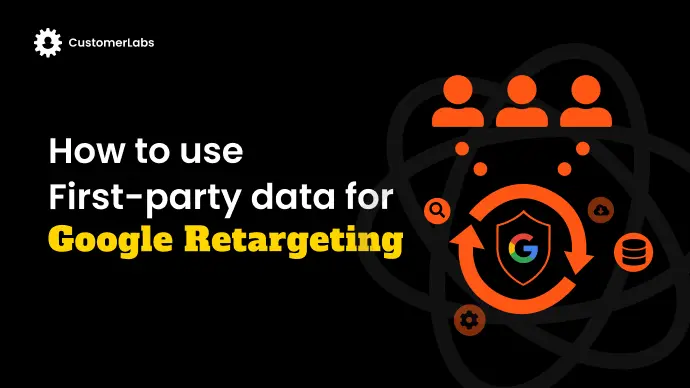A survey conducted by Statista found that 54% of global brands use first-party data exclusively to personalize customer experiences, citing higher data quality and easier management. And when these brands leveraged first-party data, they saw improved conversion rates and stronger customer retention. Why? Because every e-commerce store or marketer is struggling with either one of the problems or both: low conversion rates or lower retention rates.
How to achieve better conversion and retention rates? By using the right data, which is nothing but the first-party data (1PD). In this blog, you will learn why ecommerce brands treat first-party data as a necessity rather than an option and how to collect and use 1P data to achieve the desired conversion and retention.
Drum roll to begin.
Why First-party data for Ecommerce is a necessity?
First-party data should no longer be treated as an option that you can compromise on rather it should be treated as a necessity that you cannot survive without.
To prove the above statement, take a look at the table down below, which clearly shows the rapid increase in the number of brands using first-party data since 2024.
But why is this happening?
In today’s online world, personalization is the only key that make the customers interact with your brand via marketing channels. It can be an ad on Instagram or Facebook that makes them resonate with the products. There is a great demand created among the users for personalization, especially in the ecommerce landscape.
When the customers demand is met, it directly impacts two things: one, the conversion and the next, the retention.
Imagine you are running an ad campaign on Meta. Assume User A is one of the customer, scrolls through jumpsuits and interacts with one of the product page featuring the jumpsuit. Now, on the screen of User A, pops an ad (the campaign that you are running) showing shoes or lip balms (anything other than jumpsuit) and there is another personalized ad (imagine this as your competitor’s😜) that shows different styles of jumpsuits. Which ad would User A probably click?
Very evident, isn’t it? Obviously, the ad with the jumpsuit. So this is conversion goes right into the pockets of your competitor.
How did your competitor targeted with the same product what the User A showed interest?
And how would you determine what the user needs? By understanding their behavioral data, which is nothing but the first-party data.
Once you understand that you can make User A make a purchase. But even after getting converted, you still don’t want User A to bounce out of your radar. So what do you do? Send in personalized offers with product recommendations, live sale, and discounts that will make User A want to buy more, over and over again. This is customer retention.
From the above instance, it is evident that the foundation towards conversion and retention starts with the data.
The data should be more accurate and reliable to get better results out of your ad campaigns. With third-party data deprecation and restrict user privacy regulations, the accuracy of the current data practices of the marketers has been compromised. This makes the marketers make their move towards solid, reliable and privacy-centric first-party data. Here is a comparison of different types of data which will help you identify the best out of it.

Let’s understand how to collect and use first-party data if you are an ecommerce marketer looking for better conversion.
Check out this blog to know more on why first-party data is important.
How to Collect and Use first-party data for better conversion?
First-party data becomes valuable only when you collect it meaningfully and activate it effectively. For your better understanding, I have dissected the collection of first-party data into three stages:
What to Collect
- Purchase Events & Order History
Track every transaction, including products bought, AOV (average order value), frequency of purchase, and time between orders. This helps build segments like “high-value customers,” “frequent buyers,” or “seasonal shoppers.” - Browsing Patterns
Capture pages viewed, categories browsed, dwell time, and navigation paths. Record behaviors like on-site search terms, filters used, clicks on banners, scroll depth, etc. This gives insights into purchase intent and content interest. Know what products or collections users are drawn to—even if they don’t add to cart. - Cart & Wishlist Activity
See what customers add to cart, save for later, or abandon. This is critical for triggering cart abandonment flows and optimizing retargeting ads. - Emails or Newsletters Engagement
Track open rates, clicks, and conversions from your email/SMS flows. Understand who’s actively engaging and what kind of messaging works best.
Where to collect
- Homepage Popups and Exit Banners
Engage new visitors with discounts or quizzes in exchange for email/SMS signup. Use these moments to collect intent-based data. - Product Pages and Blog Articles
Add interactive elements like “Find Your Fit” quizzes, wish listing, or product review prompts to collect behavior and preference data. - Checkout and Thank-You Pages
Beyond the essentials (name, contact), you can collect optional data like birthday, shopping reason, referral source, and delivery preferences. - In-App or Mobile Notifications
Use your app to send notifications to collect engagement patterns and send personalized nudges. - Subscription and Landing Pages
Use landing pages with gated offers, bundles, or VIP clubs to collect preference-based data up front.
How to collect
- Sign-Up Forms, Surveys, and Quizzes
Use interactive formats to gather zero-party data like preferences, skin type, product usage, budget range, or personal goals. - Loyalty & Referral Programs
These programs naturally encourage customers to provide more data—like birthdays, buying habits, and social shares—in exchange for rewards. - Post-Purchase Feedback Forms
Gather reviews, ratings, or feedback on the delivery/product experience. These can also include optional questions that help segment customers based on satisfaction or interest.
- Server-side Tracking
Client-side pixels are prone to ad blockers and browser restrictions. Server-side tracking ensures higher reliability and enables you to send event data directly to your ad platforms (Meta, Google Ads, etc.).

Ways to Use First-party data for higher Conversions
Now that you know what, where and how to collect first-party data, let’s deep dive into effective ways to apply 1PD strategies to your ad campaigns for higher conversion.
You can use the purchase events data that you collected to optimize your ads
Imagine that you have collected the AOV event data; now you can segment the data as low, mid, and high AOV data. Next, determine the campaign objective as increasing high AOV purchases, send the segmented high AOV events data to Meta for ad optimization, and target the right users with the appropriate ad creative.
By optimizing your ad campaigns with segmented high AOV events (first-party data), the possibility of it reaching the right audience is extremely high since you are training the ad algorithms with proper event data, which ultimately increases the probability of conversions.
You can create Lookalike from the Purchased audience data (category-based audience)
By targeting with the user’s first-party data, that is, the user data that you collected based on their purchase history, you can increase the frequency of the conversions. For precise targeting, you can segment the purchase data based on categories or products. And remember to be determined to set your campaign objective; in this case, it will be to increase the sales for a specific product or category.
Now, you will setup ad campaigns by sending in the only the specific category purchase event to Meta. Since you feed Meta’s ad algorithms with good data, it will target them for more successful conversions.
You can retarget audience based on the website interaction
By collecting the website interactions of the users (first-party data), you can increase conversions by setting up effective retargeting campaigns. How to make them effective is the question? To answer that, it is purely based on how you build strategies using 1PD.
Segment the website interaction such as product viewed 3 times in a week but did not purchase, Viewed the product page but did not click, products added to cart but did not complete the purchase, wishlisted products, initiated checkout but did not make the payment and you strategically keep segmenting them as many as you can.
Setting up retargeting campaigns to the users who have initiated checkout but did not make the payments has the higher probability of getting converted. You can push the users towards by just giving them a discount or a flash sale messaging through your ad campaigns.
Know more on how to do add to cart, checkout and many more events tracking.
You can send in personalized product recommendations
With the first-party data, with the same segmentation that you have done for retargeting, you can use them even to show product recommendations. Here, you can use the events data, “added to cart but did not purchase” “viewed a specific product but did not click.” You don’t have to stop with that; you can even target people based on their previous purchases.
Now, you will send this event data to Meta and set up two separate dynamic ad campaigns and showcase the products that users showed interest in or interacted with. This strategy will make the users by triggering their desire to make a purchase. You can also use a FOMO messaging style to create an urgency and push them towards conversion.
You can improve the on-site experience in real time.
Using first-party data, you can provide personalization through your website to push them towards conversion and also enhance the user experience. You can insert exit-intent offers only to users who added products to their cart but didn’t check out.
Additionally, you can send in targeted urgency messaging to the returning users, such as “Only 3 left in stock for your size!” and you can also do smart product recommendations by displaying “Recommended for You” sections based on category viewed or previous purchases. These implementations, when brought together, can bring a major impact on overall conversion rates.

Now that you understand how 1PD can improve conversion for your e-commerce stores, let’s go with 1PD to enhance the process of retaining customers.
Role of First-party data and its Strategies in Customer Retention
It will costs 5X higher to acquire new customers than to retain existing customers. You might have already about this saying. Yes, that’s true. Enriching and nurturing your existing customers can help you on a longer run. The success of an ecommerce brand is evaluated by its loyal customers.
So, how does first-party data help with customer retention?
According to a survey conducted by the CMO Survey demonstrated that companies are witnessing 68% increase in CLV using First-party data.
With first-party data strategies, you will be able to build a relationship with the customers who ultimately become the loyal brand support system. By analyzing first-party data, you will be able to understand the customer needs, even after completing the purchase. Through these precise individual nsights on the customer behavior, you can provide personalization catering you the every need of the users.
Through personalization with first-party data, users not only become repeat buyers, but also recommend or refer a friend and bring in new customers to the brand.
And 91% of users highly engage and purchase from brands that provide personalization throughout all the marketing channels, according to a report by Accenture.
Let’s get into the first-party data strategies for customer retention
1PD strategies for Customer Retention
Setup Personalized Retention Campaigns
Using first-party data, setup personalized campaigns with the clear campaign objective to retention customers. Collect the purchase data of the existing customers and setup retargeting campaigns with products or accessories that can be paired with the purchased products.
For example, the user who has purchased a hair straightener might be interested in an all-in-one hairstyling product. Implement the upselling and cross-selling strategies so as to increase the LTV of the customer. You can also run milestone-based campaigns with the signup or birthday data and target users with messaging such as “It’s your 1-year anniversary with us—here’s 15% off as a thank you!”
Smart Retention Loops
Setting up personalized automated real-time notifications through emails and SMS acts as a reminder to the users of your products. These automated notifications or campaigns provide the right timely message to the audience through the right medium.
You can automatically follow up when a user adds products to the cart but leaves without purchasing and send in reorder reminders for consumable products. This will make the users refill the products in time, thereby developing a purchasing routine that will make your brand a go-to place.
Segmented Messaging
With the purchase data of the users, you can send in post-purchase educational messaging, such as how to use or clean the product effectively. You can also use this opportunity to upsell products. Sending these personalized messages makes the users feel valued and informed.
Loyalty programs for Customers
Structure loyalty programs for customers who have continued to purchase from your brands. It should be a reward system, which would make the customers feel that you are providing them with special treatment since they kept buying from you.
This reward system can be anything; it can be discount coupons, reward points being added after every purchase, exclusive memberships, etc. Get as creative as you can. You can also segment the users based on their LTV or AOV and structure loyalty programs accordingly.
These are some of 1PD strategies to retain your customers and ultimately increase their customer lifetime value with your ecommerce brands.
However, adapting to first-party data can be challenging as the data is collected from multiple sources and touch points.
Keep reading. The next section will guide you on how to switch gears to first-party at ease
How to get started with First-party data for Ecommerce brands
- Track and Collect using 1P Domain server-side tracking
- Unify the customer data for a detailed 360 View
- Analyze the data by evaluating the source and revenue generated
- Segment audience for higher conversion
- Activate the data by sending it back to the ad platforms
- Achieve improved targeting and enhanced conversions
- Increase in Retention and revenue
Conclusion
I believe that you are clear with the importance of building the foundation with first-party data and how it can be strategically used to bring in the desired conversions and retain customers. As brands become more aware of the impact that first-party data can have on their marketing, being able to start with it can help you outrun your competitors.
Implement the above-mentioned strategies using 1PD and if you have any queries, feel free to get an opinion from the 1PD Ops experts. They are always here to help you out.







